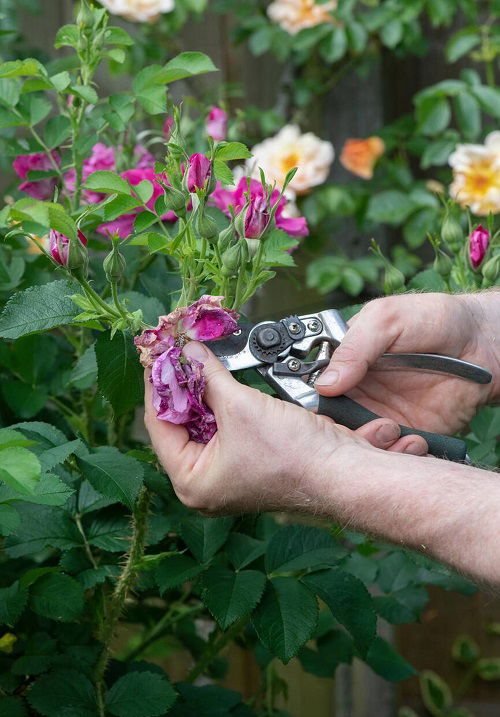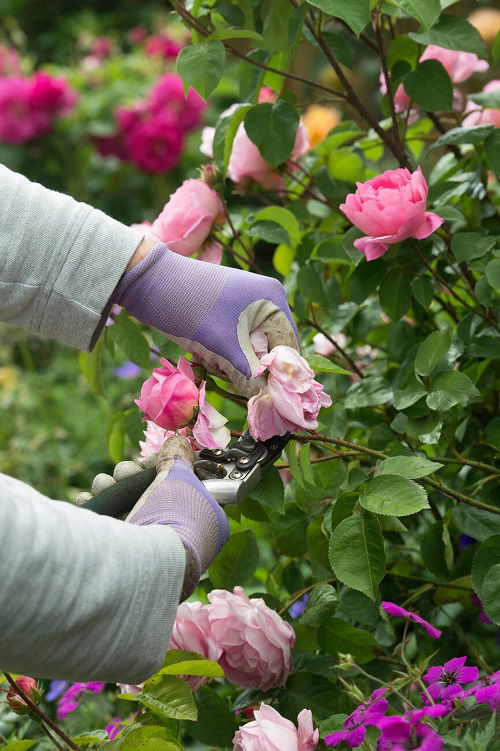Learn How To Deadhead Roses the right way, as snipping off spent flowers from a rose bush is the best way to make it bloom profusely.
Do you want to know why some gardeners have continuous blooms on their roses every season? Well, there is no secret involved; it’s some extra care and regular deadheading that keeps the plants healthy and helps them grow more flowers.
Should You Deadhead Roses?
A faded flower can make a plant look quite tatty, and with a bit of downpour on it, it may turn into a slimy mess. This can also lead to fungal infections and dieback of the stem. Also, when you don’t snip away a spent flower, the plant directs its energy to saving it and making seeds, which it can otherwise use on creating new blooms.
In a nutshell, deadheading helps to keep your rose garden looking neat and well-maintained.
How To Deadhead Roses?
Before you start, you’ll need two things: gloves (good for thorny roses; if you want to grow non-thorny ones, we have tips for that) and secateurs.
1. For Heavy Flowered Roses
For heavily flowered roses, remove individual flowers carefully from the cluster as and when each one’s petals begin to fall. After this, snip it with secateurs or pinch it using sharp fingernails without damaging the cluster. This will make sure that your plant looks good while the other buds are open.
Once all the flowers in the cluster finished blooming, remove the entire spent stem below the bunch of flowers as well, cut back to just above first set of leaves.
2. For Single Flowered Roses
As the name gives it away, such rose plants have a large, single flower on the stem. They are easiest to prune as you only have to deal with one flower while cutting it off from the plant. Snip away the spent bloom on the stem by just cutting above the healthy leaf.
When cutting above the leaf, make sure to leave at least two leaves below the cut to ensure the stem remains healthy.
3. For Rambling Roses
Rambling roses have long and flexible stems, which you can easily train on a trellis or a frame. They are perfect for covering walls and archways, growing significantly smaller flowers in size, and blooming throughout summer and fall, and also give off a sweet and heady scent.
For rambling rose varieties that bloom only once a year, deadheading immediately is less important as they won’t produce more flowers until the next season. You can wait for the flowering cycle to end to remove the blossoms.
However, for repeat-blooming cultivars, regular deadheading can encourage continuous flowering. So, you can remove the fading blooms straight with secateurs after they start to dry off.
4. For Knockout Roses
You don’t need to worry too much if you don’t know how to deadhead knockout roses. These roses are known for their continuous blooming and low-maintenance nature. They’re also disease-resistant and bloom all season long.
Unlike others, knockout roses are self-cleaning and don’t require deadheading. Their spent blooms naturally wither and fall off on their own, revealing fresh buds underneath. Deadheading can help prevent the spread of fungal diseases if the blooms rot or become moldy. But that’s a rare case.
With regular deadhead techniques, you can increase the number of high blooms in your garden. Make sure you do it on a regular basis!
Now that you know how to deadhead a rose bush, you can have a beautiful rose garden. Do let us know how it goes for you in the comments below!




